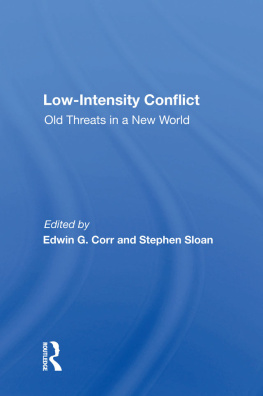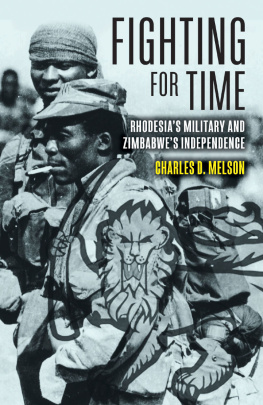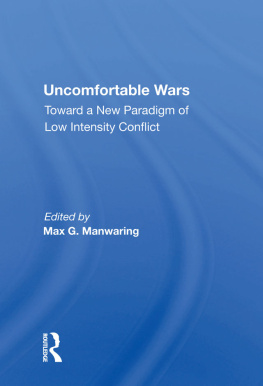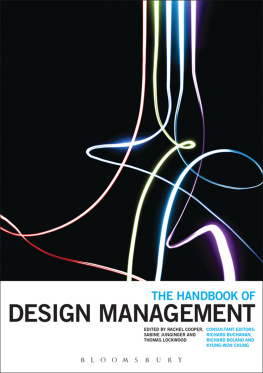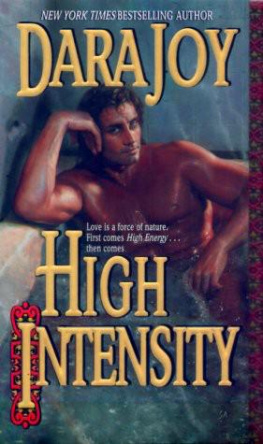Low-Intensity Conflict
Westview Studies in Regional Security
Wm. J. Olson, Series Editor
Low-Intensity Conflict: Old Threats in a New World,
edited by Edwin G. Corr and Stephen Sloan
The Military, the State, and Development in Asia and the Pacific,
edited by Viberto Selochan
The Comandante Speaks: Memoirs of an El Salvadoran Guerrilla Leader,
edited by Courtney E. Prisk
Uncomfortable Wars: Toward a New Paradigm of Low-Intensity Conflict,
edited by Max G. Manwaring
U.S. Strategic Interests in the Gulf Region,
edited by Wm. J. Olson
Forthcoming
The Emergency in Malaya, 1948-1954,
edited by John Coates
The U.S. Counterinsurgency Campaign in Thailand,
edited by William Rosenau
Low-Intensity Conflict
Old Threats in a New World
Edited by
Edwin G. Corr and Stephen Sloan
First published 1992 by Westview Press, Inc.
Published 2018 by Routledge
52 Vanderbilt Avenue, New York, NY 10017
2 Park Square, Milton Park, Abingdon, Oxon OX14 4RN
Routledge is an imprint of the Taylor & Francis Group, an informa business
Copyright 1992 Taylor & Francis
All rights reserved. No part of this book may be reprinted or reproduced or utilised in any form or by any electronic, mechanical, or other means, now known or hereafter invented, including photocopying and recording, or in any information storage or retrieval system, without permission in writing from the publishers.
Notice:
Product or corporate names may be trademarks or registered trademarks, and are used only for identification and explanation without intent to infringe.
Library of Congress Cataloging-in-Publication Data
Low-intensity conflict : old threats in a new world / edited by Edwin G. Corr and Stephen Sloan.
p. cm. (Studies in regional security)
Includes bibliographical references and index.
ISBN 0-8133-8593-8 (hc) : ISBN 0-8133-8594-6 (pb):
1. World politics1975-1985. 2. World politics1985-1995. 3. United StatesForeign relations1977-1981. 4. United StatesForeign relations1981-1989. 5. United StatesForeign relations1989- . 6. Low-intensity conflicts (Military science)History20th century. I. Corr, Edwin G. II. Sloan, Stephen. III. Series.
D849.L69 1992
909.82'8dc20
92-17572
CIP
ISBN 13: 978-0-367-01147-5 (hbk)
This book is dedicated
by Ed to his loving parents, Rowena and E. L. "Bert" Corr,
by Steve to Michael Joel Weiss, one of the best and brightest,
and to
the twenty million people who
have perished in low-intensity conflict
since World War Two.
Contents
, Dr. Wm. J. Olson
, Senator David L. Boren
PART ONE
The Challenge, the Concepts, and the Context
, Professor Stephen Sloan
, Ambassador Edwin G. Corr and Ambassador David C. Miller, Jr.
, Dr. Max G. Manwaring
, General John R. Galvin
PART TWO
Selected Cases of Low-Intensity Conflict
, Dr. Robert F. Zimmerman
, Professor Caesar D. Sereseres
, Ambassador James Cheek
, Professor David Scott Palmer
, Mr. Sean K. Anderson
, Dr. David C. Isby
, Ambassador Edwin G. Corr and Colonel Courtney E. Prisk (Ret.)
PART THREE
Implications and Conclusions
, Dr. Thomas A. Grant
, Professor John Norton Moore
, Admiral William J. Crowe
, Professor Stephen Sloan
Guide
Your tale, sir, would cure deafness.
Shakespeare, The Tempest
We have arrived on the shores of a brave new world after a dire and turbulent voyage. For more than forty years we have lived with the certainties of rivalry with the Soviet Union and the defining features of a policy of containment. Although it was a period filled with many cares and sorrows, there was a coherence and consistency of purpose that lent us reassurance on the often vexing question of how this country should determine its international role.
As a nation we have been most comfortable as a symbol or an inspiration to others. Believing in the soundness of our founding principles, initially we were mostly inclined to remain aloof from a world whose politics and intrigues we found distasteful. George Washington's familiar words to avoid entangling alliances were less an admonition to the fledgling nation than a reflection of a deep psychological element in the American character. Yet, as the world has grown more complex and fearsome since his day, the bent of our natures to remain aloof has undergone stress and change.
The world simply would not leave us in peace. Nor, ultimately, would our own native restlessness and sense of what is proper be reconciled to idle watching with the approach of World War II. Thus, when our sense of responsibility clashed with our sense of isolation, we chose, rightly, the former. It was never a comfortable decision, however, and it is one that has remained troubling.
The consensus that sustained our postwar containment policy was showing major fault lines in recent years, and it is only the collapse of the Soviet Union that has forestalled a crisis in U.S. foreign policy. Ironically, or perhaps inevitably, the disintegration of our former adversary has not postponed the critical review suggested by that decline. It has only deflected it into an area whose features are even harder to discern. Far from ending ambiguity or simplifying questions about our role in the world, the demise of our enemy presents us with even greater uncertainty as to the nature of the world we face and leaves us more unsure of what our purpose should be.
This present volume attempts to provide, if no final answer, a timely and true definition of the challenges we face and the course we should undertake. It is a partisan book. It clearly sides with the universal bent of our nature. It makes it clear that the world will be very much with us, demanding our attention. It also describes the nature that much of the threat is likely to take.
Today we face a range of contradictory challenges in distant jungles and urban environments. In many of these conflicts it is hard to discern or explain concrete U.S. interests that would justify our serious involvement. This was so when we still had the Soviet threat to validate our concerns. Now that underpinning, that imperative for action that subdued our inclination toward aloofness, no longer has the force to ratify the type, scale, or longevity of involvement that these situations require. It remains unclear just what the American public will support as an expression of its interests in the larger world or what use of U.S. power overseas it will sustain.
What challenge to our basic values and survival is posed, for example, by the Sendero Luminoso in Peru, however murderous and cruel they may be? What interest is at stake that should see us engaged in small countries such as El Salvador? With the demise of communism, what rationale is left for becoming involved in distant, obscure struggles? With so many concerns at home, what should we care for the squabbles of others?
This volume frames the issues for intelligent debate. The genius of the American people has always been in our pragmatic idealism, our willingness to take the measure of a problem and then get to work doing something about it. We have a bit more in our character of the reflexive than the reflective, and ambiguity troubles our collective soul. Clearly, however, we have serious issues that will demand our best efforts, both intellectually and materially. There are no easy answers, nor do we have the luxury of a clear and present danger around which to coalesce.

